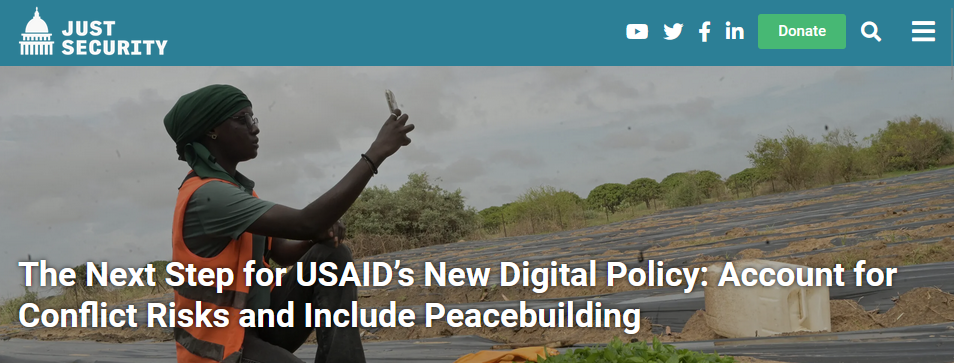We’re starting a new feature here at PaCS… case studies! In these case studies, we’ll look at the nitty gritty of communications strategies of various peacebuilding and social impact organizations. The idea is to create a learning library for other professionals in the field.
Drumroll please for our first case study….
Nick Zuroski from the Alliance for Peacebuilding and Claire Guinta from Nonviolent Peaceforce recently co-wrote an op-ed, “The Next Step for USAID’s New Digital Policy: Account for Conflict Risks and Include Peacebuilding” that appeared in Just Security.
How did you come up with the idea to write an op-ed for Just Security on USAID’s Digital Policy?
After submitting feedback to USAID during the comment period for its forthcoming Digital Policy, Nick and I (Claire), along with our colleagues, led the response from the Alliance for Peacebuilding (as the lead organization) and Nonviolent Peaceforce (as a member). When we saw that the final version did not reflect the comments we submitted, we realized that our feedback could serve as the foundation for an op-ed. We wanted to provide clarity around how digital technologies can drive instability, violence, and conflict, as well as highlight how peacebuilding and protection are frequently overlooked or poorly integrated into other sectors. With the implementation plan on the horizon and the importance of shaping the operationalization of a 10-year strategy, we saw an urgent need to bring this conversation to a broader audience.
Why did you choose to publish in Just Security?
We chose Just Security because of its reputation as a leading platform for analysis and commentary on law, rights, and U.S. national security policy. It provides a respected space to engage policymakers, practitioners, and thought leaders on critical issues. It also strikes a nice balance between detailed policy recommendations and digestibility for outside audiences. Given our recommendations on the intersection of digital security, peacebuilding, and protection in USAID’s policy, we felt Just Security’s audience would be particularly well-positioned to understand the implications of our argument and help drive the conversation forward. It was the ideal outlet to reach the decision-makers and advocates who could influence the policy’s implementation.
What was the process like to get your piece published?
We had an editorial contact at Just Security. We had some back and forth over the course of a few weeks—with probably 3 or 4 rounds of edits.
What has the ROI been on publishing the op-ed? How has it helped move forward your organizational goals?
We shared it directly with USAID and other key stakeholders, positioning our feedback in a broader public discourse. Internally, the op-ed has served as a valuable reference point, helping to sharpen and strengthen our organizations’ stances on digital policy and its intersection with peacebuilding and protection.
Externally, it has showcased us as thought leaders in a niche area where few others are actively engaging, increasing our visibility and credibility. This has not only elevated our voice in discussions around digital security, but also aligned with our organizational goals of integrating peacebuilding and protection into critical policy spaces.
The op-ed has also proven valuable in specific advocacy efforts, such as during PeaceCon (AfP’s annual conference), where we were able to reference it in conversations with panelists from civil society and government, including USAID officials working on gender-based violence. It provided a concrete example of our leadership at the intersection of digital security, peacebuilding, and protection, helping to establish credibility and foster deeper dialogue on these critical issues. This opportunity to connect our work with ongoing initiatives at USAID has reinforced the importance of integrating these perspectives into broader policy discussions. Moving forward, the piece can serve as an instrument for channeling ongoing recommendations as USAID moves forward with its implementation plan for the Digital Policy.
What do you wish you’d done differently? What advice do you have for others who might want to try something similar?
We wish we had published the op-ed earlier—specifically during the comment period—so we could have another opportunity to influence the policy while it was still in development. Timing is critical when trying to shape public discourse and policy decisions, and publishing earlier might have given our feedback greater visibility and impact. Following up with a second piece after the policy’s release would have also helped maintain momentum and accountability. For others considering a similar effort, our advice is to act quickly and strategically. Identify the most opportune moments to amplify your voice—whether during a comment period, before a key decision, or after a policy’s release—and plan a follow-up to sustain attention.
Ready to amplify your impact? Consider an op-ed as your next strategic communication tool. And let me know if you need some help crafting it.

